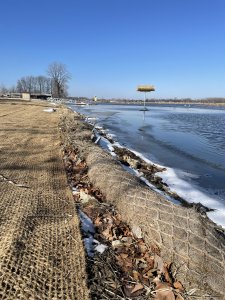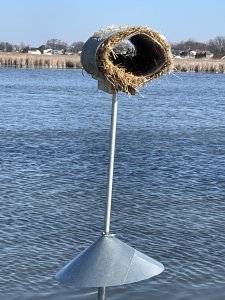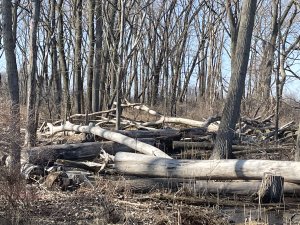Change is a Shore Thing at Lake St. Clair
March 1, 2023
By Erin Parker, Interpretive Services Supervisor
Visitors to Lake St. Clair Metropark may have noticed some changes starting late last summer and into the fall. At the marina, instead of thick, rocky rip-rap there are now long rolls of coconut fiber coir that lie parallel to the water’s edge. A large number of dead trees throughout the park have been removed or have fallen, causing the visitor’s view of the park to look dramatically different in some places. Lake St. Clair Metropark’s location along Black Creek and Lake St. Clair provide a living laboratory to observe changes in the entire Great Lakes. As water levels have fluctuated through time, the impacts on the park, park users, and park wildlife are all evident.

Softened shorelines
Rip-rap and other hard surfaces were once believed to the best way to reduce scouring and erosion of the shoreline by changing water levels, winter ice, and heavy waves. Often these hard surfaces caused the reflection of wave energy, redirecting it elsewhere. This means that while a tiny piece of shoreline might be preserved by the hard surface temporarily, it caused more erosion elsewhere often undermining the hard structures themselves over time. Hard surfaces also reduce the deposition of sand, silt, and other organic matter that would happen in naturalized systems.
Softened shorelines, sometimes called living or natural shorelines, are a modern approach to shoreline protections that take into consideration a variety of factors including water and wind movement as well as the creation and protection of wildlife habitat. Green infrastructure, including these natural shorelines, can also help support larger goals including reduced maintenance costs, increased stormwater and flood buffering, and development of nursery habitat for fish and other organisms. As plants grow, they help hold the shoreline into place, collect sediments, and soak up stormwater while simultaneously feeding and sheltering wildlife.

As visitors come back to Lake St. Clair Metropark to fish, boat, launch a kayak, or otherwise enjoy the marina, they’ll also notice an addition of some duck nesting areas. Some are the traditional wood duck box and others are a long tube, believed to best suit mallard ducks.
Tree canopy changes
Record high water years in 2019 and 2020 caused flooding throughout the park, eventually killing a large portion of the park’s giant cottonwood trees. These dead trees, making up a substantial portion of the forest canopy throughout the park, are now being assessed as hazards. Heavy wind, snow, and ice pull down branches and even entire trees, creating a dangerous situation for park users and staff where trees overhang structures, trails, and parking lots. Plans to eventually replant trees, with an eye on native species that can provide shade and wildlife value while simultaneously being more resilient to changing water levels, are in the works.

Standing dead trees, left in areas of the park where they won’t cause harm when they eventually fall, provide important habitat for wildlife. Red-headed woodpeckers were observed in park several times in 2022 after many years of absence. These and other species that nest in tree cavities are particularly likely to make use of standing dead trees.
Dead trees left on the ground after being cut or falling are just as important. These trees eventually break down into organic components of the soil, feeding the next generation of trees and forest plants. But as they decay, they provide food, shelter, and habitat for invertebrates, amphibians, reptiles, birds, and mammals. Branches and trees that fall into the canals or water provide critical structure for fish and other aquatic animals. Even in death, the park’s trees provide a value.
As you enjoy the park’s many features this year, you’ll likely notice some of these changes. Keep an eye (and ear) out for wildlife and new growth. The only constant in nature is change, after all!
